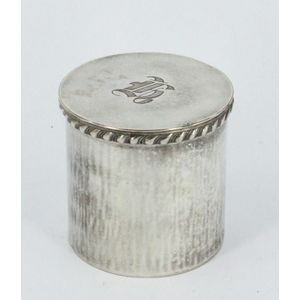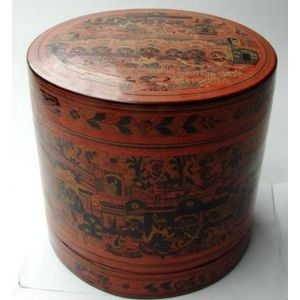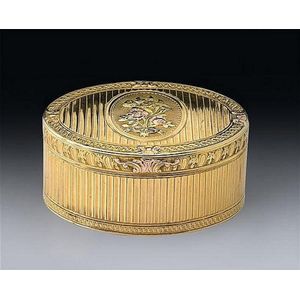French Tri-Coloured Gold Snuff Box, Paris 1769/1770
You must be a subscriber, and be logged in to view price and dealer details.
Subscribe Now to view actual auction price for this item
When you subscribe, you have the option of setting the currency in which to display prices to $Au, $US, $NZ or Stg.
- Cartouche - An ornamental panel in the form of of a shield, oval or rectangular scroll with curling edges. It may be carved into the back of a chair or the top of a sideboard, or present on a piece of silver or jewellery, and contain the initials of the original owner, heraldic symbols, or some other inscription, such as the details of a presentation.
In ceramics the term defines the central area of a vase or similar with a decorative border in one of the shapes above, into which a decorative scene or figures have been painted. - Guilloche - A form of classical decoration consisting of a repeating ornament of interlacing curved bands, sometimes forming circles, and further decorated with rosettes or other flower forms.
The name is derived from the inventor, French engineer Guillot, who invented a mechanical method of inscribing fine repeating patterns on to metallic surfaces.
On enamelled items with guilloche decoration, the surface is firstly engraved with the repeating pattern, and then covered with several layers of enamel, each of which is fired.
Where the item has not been enamelled the form of decoration is usually called "engine turned". - Circa - A Latin term meaning 'about', often used in the antique trade to give an approximate date for the piece, usually considered to be five years on either side of the circa year. Thus, circa 1900 means the piece was made about 1900, probably between 1895 and 1905. The expression is sometimes abbreviated to c.1900.
- Engine Turned - Engine turning is a decorative technique used on metal surfaces to create intricate curving or geometric pattern. The process involves cutting a series of lines into the surface of the metal using a rose engine or decoration lathe which rotates the metal as it cuts, allowing the operator to create a repeating pattern that covers the entire surface. The resulting surface has a shimmering, reflective quality that is often described as "engine turned." Where an engine turned item has been enamelled, the term used to describe the decoration is usually guilloche.
Engine turning was originally developed to decorate metal objects such as firearms, scientific instruments, and other metal objects that required precise and elegant design. - Foliate - Decorated with leaves or leaf-like forms.
This item has been included into following indexes:
Visually similar items

An Old Sheffield plate round trinket box, monogrammed. Height 8 cm. Weight 234g.

Antique French plate silver snuff box, extensive embossed decoration to lid, base & sides. Gilt washed interior. Provenance: enclosed in the snuff box is copy of letter indicating that it was originally the property of Major General Drummond, who carried i

A large Burmese lacquered betel nut box, circa 1920, painted with courtly scenes including six panels with Burmese script, detailed and elaborate scenes of the King with ministers, elephants decorate the tall sides of the inner base walls, the box retains

A quality wide gold bracelet, 18ct yellow gold, made as a retro styled bracelet of slightly domed verticals panels, the central section of each panel finished in a matt satin finished gold with the outer sections in a high polished effect creating a frame,
